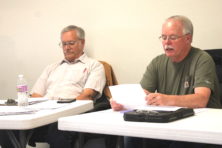SDFD Preparing to Reorganize, Minus Nasewaupee
- Share
- Tweet
- Pin
- Share

After what Forestille village president Terry McNulty called a “last-ditch effort” to persuade the Town of Nasewaupee to remain in the Southern Door Fire Department (SDFD) was unsuccessful last month, the other three municipalities are now preparing for what will happen to the SDFD before Nasewaupee starts operating its own department in the fall of 2023.
McNulty, Forestville town chair Kevin Guilette and Clay Banks town chair Myron Johnson wrote a letter to Nasewaupee town chair Steve Sullivan urging him to continue working with them as part of the SDFD, but none of the five members on Nasewaupee’s board expressed an interest in staying during their April 20 board meeting.
That prompted the boards of the Village of Forestville and the towns of Forestville and Clay Banks to act last week on resolutions related to reorganizing the SDFD, which was formed by the four municipalities in 1980.
Those resolutions call for the board chairs of the SDFD’s three remaining municipalities to work together to negotiate the separation of Nasewaupee from the department and to provide for the continuation of fire protection beyond Sept. 27 – when Nasewaupee’s split would be effective – with a new operating agreement.
The SDFD now has a north station in Nasewaupee and a south station in the Village of Forestville. Nasewaupee gave the other three municipalities a one-year notice at the fire board’s annual meeting in September 2022 that it planned to split from the SDFD and would exercise its option under the department’s current operating agreement to purchase the assets in the north station.
The operating agreement forming the SDFD states that Nasewaupee, should it decide to leave the department, would have the first option to purchase the pieces of equipment housed at the fire station in the town “at their then-fair-market value.”
To own the north fire station and its equipment upon leaving the department, the operating agreement states that Nasewaupee would be required to pay the remaining municipalities “an amount equal to the percentage of the then-fair-market value of the property contributed by the remaining municipalities.”
To finalize that, the parties would need to agree on the equipment’s value and the percentage of that value that Nasewaupee should pay. Nasewaupee is paying more than two-thirds of the cost to run the SDFD through a tax levy based on equalized value, and Sullivan said it’s the town’s position that it should pay 32% of the cost of what it purchases, with the money to do so coming out of the town’s reserve funds.
McNulty said it’s not certain at this point what it will cost to operate the SDFD with three municipalities instead of four, one fire station instead of two, and fewer firefighters and fewer pieces of equipment with the department splitting.
The current annual SDFD budget, finalized last September, included $433,863.93 in revenue and expenses. Of around $409,000 in the total tax levy contributed by the four municipalities, approximately $293,000 is Nasewaupee’s portion.
The Village of Forestville’s share, in contrast, is the smallest, at about $15,000 of the SDFD’s tax levy, and McNulty said he’s concerned what the tax impact on the village will be without Nasewaupee in the department. To keep property taxes down, he said he hopes the village won’t have to cut its own budget for municipal services in the event there is an increase in the SDFD tax rate, which is currently at .55 mills.
McNulty said that the cost for the remaining three municipalities to operate the SDFD may not be known until a year after it reorganizes.
Though Nasewaupee would no longer be in the SDFD, he said the department would still provide mutual aid to other fire departments, and Nasewaupee now accounts for about two-thirds of the calls in the SDFD’s coverage area.
Sullivan said he hopes Nasewaupee, not including the purchasing of equipment, will be able to operate its own department for about $200,000 a year – less than what the town now pays in property taxes – but that figure is far from firm at this point, with the town yet to purchase a pumper truck.
An eight-member fire board composed of two representatives from each municipality currently oversees the SDFD. Nasewaupee sought to have more representation on the board and lower the percentage it contributes to the department before it took steps to split from the SDFD.
McNulty said the other three municipalities last month considered making the representation on the fire board more in line with population to give Nasewaupee two more representatives and lower the percentage it pays, but that did not persuade Nasewaupee’s board members to stay.





